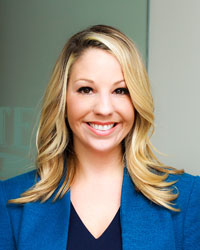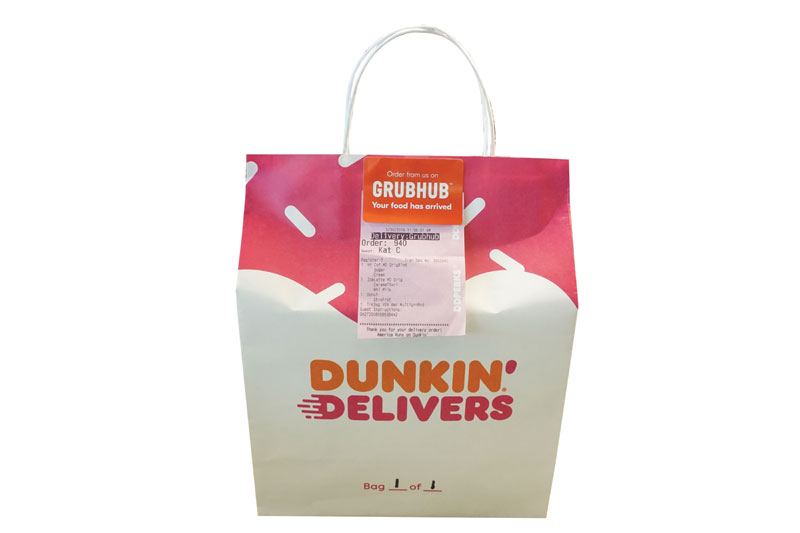
Brandy Blackwell – Dunkin’
As Dunkin’s new director of catering and delivery, Brandy Blackwell has her work cut out to improve convenience in a system with close to 9,500 locations in the U.S. With millions of Americans living above or adjacent to a Dunkin’ or, at the least, passing one on their commute, it’s an interesting experiment to make a brand that’s nearly ubiquitous even more accessible.
Given its massive footprint, Dunkin’ signing with Grubhub to bring delivery to 400 NYC locations was a big deal for both parties. Blackwell said she feels the chain has a leg up on other players because of its universal name recognition. That, she said, could help it scale up catering and delivery sales quicker than other brands.
The Grub partnership, announced in June, generated significant chatter in the investment community, with several analysts singling it out as a major factor for the closely watched delivery brand’s financial performance between now and the end of the year. On the Dunkin’ side of the fence, Grubhub’s strong presence on the East Coast was a major factor in signing the contract.
“Why we really chose Grubhub from the get-go is, naturally, they cover over 75 percent of our footprint as of now and that’s growing every day,” Blackwell said. “Even more important, they really aligned with our urban footprint.”
She also cited Grub’s built-in point-of-sale integration which reduces wait times, improves accuracy and helps on the back-end accounting side—all items she said were non-negotiable.
Formerly focused on delivery and catering at McAlister’s Deli, Blackwell has taken on a newly created position at Dunkin’. While she’s universally positive about delivery’s prospects for the system, its diversity of store sizes and locations means there will naturally be some “self cannibalization” with some performing better than others. In New York City, for example, one apartment or office seeking delivery could be within the delivery radius of several Dunkin’ locations. That means part of the franchisor’s work includes finding the most efficient way forward and using larger locations as catering and delivery hubs.
“I wouldn’t say sales are going to be less, they’re just going to be reallocated and spread out across more stores,” she added. “The other thing, if you can get a Dunkin’ on every single corner your delivery sales might not be as high, because the fact that you could walk downstairs in your building and go to Dunkin’ would mean you’re less likely to have something delivered—so those are some variables.”
The brand’s best opportunities are what Blackwell called “a nice hybrid of business and residential” near a store, which can boost weekend volume, which she said “feels very incremental to franchisees” because weekends tend to be slower than the Monday through Friday morning grind.
So far, delivery check sizes are two and a half times larger than single, in-store orders. That means more of the delivery orders are destined for groups, like workplace meetings. Whether it’s catering or individual deliveries, part of the company’s focus is driving attachment of food items to help justify the cost of delivery.
“If you’re going to pay a delivery fee, possibly a service fee and tip somebody, you don’t really want that total to be higher than what your actual item is that you’re ordering,” Blackwell said. “I think that will continue to be the trend as we continue to work on different opportunities to raise that check average even higher.”
With delivery capturing more attention from Dunkin’ execs, Blackwell has a seat at the table for future initiatives, like suggesting delivery- and catering-friendly new menu items. At present, its in-store mix skews toward beverages, which makes sense, while delivery orders tend to have more food than coffee.
“In the delivery business, the providers will tell you that food is the driver generally, and the mix we’re seeing on delivery is similar to what the industry sees,” she said. “It’s interesting that it’s completely flipped for our brand, so that’s a great opportunity for us to test.”
Additional testing has focused on tweaking the menu focus to match the conditions at hand—pushing iced coffee when the thermometer spikes and espresso in younger areas, like locations near college campuses.
“It’s kind of what you make of it,” she added. “The opportunities are really there, it’s just understanding who your consumer is, who you want to target, and pushing your peaks and pushing your valleys.”
As a frequent speaker at delivery- and catering-focused events, Blackwell said newcomers to the space should talk to as many people as possible outside of their organization to learn what’s working and isn’t for other brands. She also recommended taking sales calls from suppliers like software integrators. Even if she’s not currently looking for new suppliers, taking such calls means she can be prepared if the corporate office changes direction or asks about competing providers. In general, she recommends saying yes as often as possible to learn more about the fast-changing off-premises ecosystem.
“For nothing else, you learn,” Blackwell said. “That’s what we all want to be, the [subject matter expert] of what we’re doing, so every day I learn something new.”


